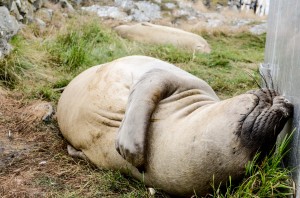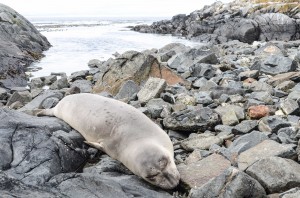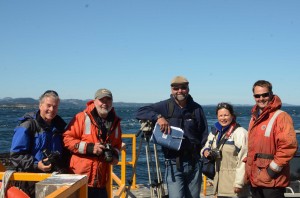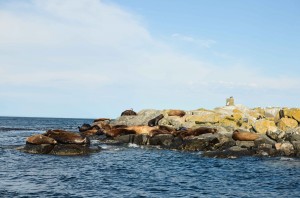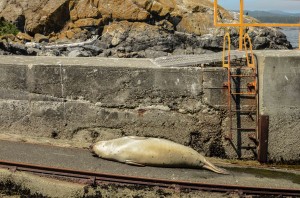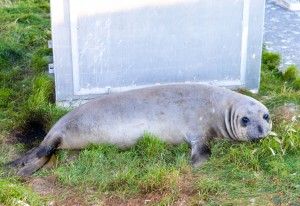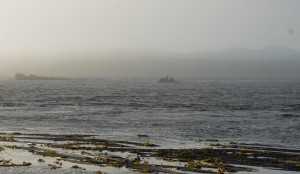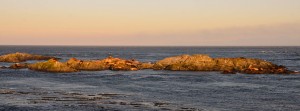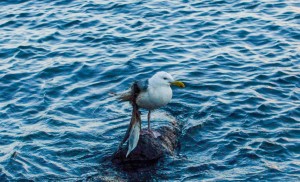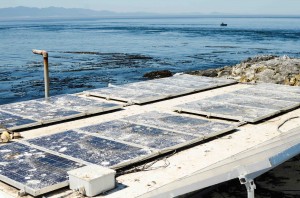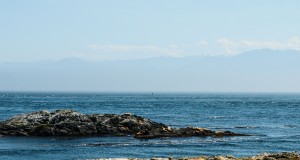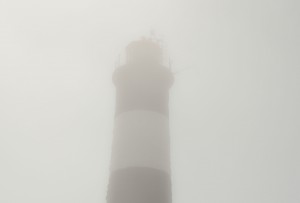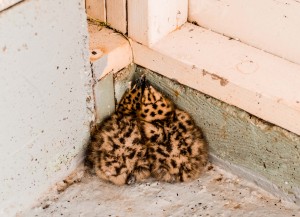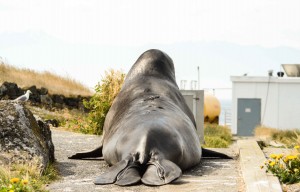Recording of temperature was started by Environment Canada in April, 2013 on this website: Compare this data set with that produced by our Davis Instrument at Ground level.
You may copy and paste into an excel spreadsheet in order to do further analysis and graphs.
Other archived weather data is being made available in the “weather -archive category”
Marine-Mania!
Another female elephant seal, significantly larger than the tagged #6375, has visited twice this week. It is not tagged. The tagged female has also stayed around. Yesterday, she was resting in the shallow water and blocking the boat ramp as I was returning from the mainland in the Whaler. I left the boat tied up so not to disturb the seal and returned in an hour. The seal had moved to a very crowded area that many of the sea lions use as their water entrance/exit and was snapping and chasing the sea lions. I assume this was playful behaviour although the elephant seal was quite aggressive.
 This first image shows the seal waiting at the surface.
This first image shows the seal waiting at the surface.
Then the seal approaches the sea lions on its back, provoking them.
And with a splash, the chase ensues!
A new project on-the-go is a daily count of the number of fishing boats. The Department of Fisheries and Oceans are wanting to monitor the impact of sport fishing in the area. We survey an area from Beechey Head to Albert Head. On some days, there more than 100 sport fishermen in the area.
Tagged elephant seal #6375
The tagged female has returned, but on the opposite side of the island. Her number is 6375, which means she’s been returning to the island since 2011 or earlier. Pictured below, she is dosing on the south side of the island.
We have had very low winds in the last few days. Even though summer months typically have less wind, it is very rare to see 0.00 knots as the wind metre read yesterday. We also had our first rain of the summer.
A week of visitors!
On Thursday we had a visit from Discovery Channel who were working with the Ogden Point Dive Centre (based out of Victoria) to film and document sea lions and seals on the reserve. They asked questions about the sea lions’ migration patterns and the role of Race Rocks as a reserve among others. The footage will be used as part of The Blue Realm series, by Danny Mauro.
The California sea lions moved onto the main Rock last week, and the Stellars have joined in the last few days. Currently, approximately 30 are resting on the rock and in the water. Misery, our largest resident male, left last week and has not returned or been spotted on the other rocks. The female in the last post has also left. However, on Saturday, a different young female was resting on the jetty. Unfortunately, I did not notice she had a tag on her back fin until she was swimming away and it was too late to mark down.
Rockfish Conservation Areas (RCAs) in B.C.:
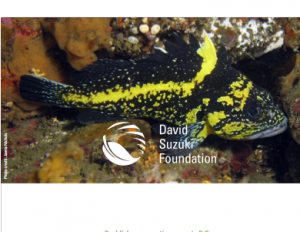 Rockfish conservation areas in B.C.: Our current state of knowledge
Rockfish conservation areas in B.C.: Our current state of knowledge
Dana Haggarty, M.Sc., PhD candidate Consultant for the David Suzuki Foundation
August 12, 2013
This 84 page report is a thorough research on the extent, purpose and effects of RCA in BC. It has very good maps of the areas involved.
See the full PDF:RockfishConservationAreas-OurCurrentStateofKnowledge-Mar2014
EXERPT: Lessons learned from RCAs
British Columbia now has almost a decade of experience with spatial protection in the network of RCAs. Several lessons from this experience should be applied to the developing MPA network:
- All empirical studies of RCAs reviewed in this report are limited by their lack of data from before the reserves were established. If proper foresight and resources are applied, this problem can be avoided and data can be collected prior to MPA establishment. For example, the system of marine reserves in Oregon is being phased in to allow for data to be collected prior to establishment (personal communication, D. Fox, Oregon Department of Fish and Wildlife). This greatly improves ability to assess performance of reserves and apply adaptive management.
- Long-term monitoring of reserves is necessary to determine their effectiveness. Assessments of which reserves are performing well and which reserves are underperforming are necessary ingredients for adaptive management (Hamilton, Caselle et al. 2010, White, Botsford et al. 2011). Monitoring data and reserve assessments are also necessary to gain and retain buy in from fishing communities. All fishing sectors interviewed for this report felt strongly that they wanted to see long-term monitoring put into place in RCAs and were anxious to know how RCAs were performing. However, it is difficult to get support for long-term monitoring. The need for monitoring should, therefore, be specified and planned for in the establishment of MPAs.
- Outreach, education and enforcement plans must also be developed and maintained for networks of MPAs. Commercial compliance with RCAs is very high since electronic fishery monitoring was put in place shortly after they were established. Recreational compliance, on the other hand, was found to be quite low. Recreational effort in 44 of 77 RCAs in the Strait of Georgia has not significantly dropped as a result of RCA establishment and compliance in many other RCAs around Vancouver Island in 2011 was also quite low. Greater education and outreach regarding RCA boundaries and regulations as well as why they are important is desperately needed. NGOs that have the ability to reach a broad spectrum of society such as the David Suzuki Foundation and the Vancouver Aquarium could play important roles in this regard. Modern tools such as smart-phone applications that employ GPS technology should be explored. These tools could both educate people about conservation initiatives as well as help people navigate in our increasingly complex world of spatially explicit management regulations. Compliance monitoring should also be built into monitoring plans to assess if regulations are having their desired effects. Enforcement must also be made a priority and supported with funding.
- Although many RCAs protect good rockfish habitat and contain good rockfish populations, not all RCAs are likely to be effective. Some RCAs were simply not well-located. A review of RCAs needs to be undertaken to identify which are likely to be successful and which are sub-optimal. White, Botsford et al. (2011) very elegantly put it: “Now that networks of reserves have been implemented worldwide, the time is ripe for the implementation of adaptive management. … Questions need to evolve from “Do reserves work?” to “When and why do marine reserves work, how long does it take, and what should we be measuring?”
A lady friend and illegal fishing
Saturday evening when collecting the water sample, I noticed the familiar glow of Noctiluca scintillans, a type of dinoflagellate that when agitated by movement in the water, lights up; a process known as bioluminescence. A curious mammal approached me on the jetty when I realized it was a female elephant seal, which haven’t frequented the island for a number of weeks now. The female didn’t come onto the main island until the following afternoon, and I suspect she is the same one that came most recently about a month ago in early July. She has returned to her usual hangout spot next to the hose box.
Illegal fishing on the reserve is hard to moderate although remains an important role of the reserve. Today I came across two Glaucous-winged gull chicks picking at what seemed to be a worm, but turned out to be fishing tackle some adult gull had probably returned with from the kelp beds.
These unexpected fisherman, above, claimed ignorance when I approached them about fishing poles in the water.
California sea lions have joined the Stellars on the southern rock.
Seawater Data: Temperature and Salinity July 2013
| Daily Seawater Temperature and Density Record Shore Station | |||||
| Time Zone: PDT | |||||
| Station Race Rocks Lightstation | |||||
| Month: ___July _________ | Year: 2013 | ||||
| Observer: Lester B. Pearson College of the Pacific | |||||
| Continue reading | |||||
Shit Happens…
Yesterday evening as I went out to collect the water sample I interrupted a couple of harbour seals feeding on a glaucous-winged-gull. Harbour seals feed on fish more commonly although they do sometimes feed on gulls. The seals, upon seeing me, fled leaving the injured gull in the water. It clumsily exited onto shore but was tripping over its dragging wing. I shooed it back to the water in hopes the seals would return. When they did not and I went out a second time to find the gull wandering aimlessly in the rocky intertidal zone. Meanwhile, the seals had returned to the jetty area and were feasting on a fish. In situations like these we have to make a judgement call and the gull seemed to be needlessly suffering. The chance of it being eaten by the seals was very unlikely since they had found other food and an eagle coming to finish the deed was also unlikely because it was late in the evening and their visits are generally midday. It didn’t seem right to let it suffer through the night so I put it out of its misery.
In other gull news, an ongoing project we’ve been working on is tilting the solar panels. Angling the panels allows more direct sunlight but more substantially, discourages the gulls from using them as resting spots. Gull droppings can have a large effect on energy intake of the solar panels. Sounds unreasonable? Here’s a picture of the panels after just one day since being cleaned.
On another note, more stellar sea lions have accumulated on the southern rocks. The count has reached over 30.
Out in the fog…
We’ve had the most fog of the summer yesterday and this morning, so thick the shoreline isn’t visible from the tower at points. The fog yesterday didn’t clear until late evening.
The gull chicks are just starting to fly, although there have been some later hatchings this year too. The parent gulls have been very protective and aggressive. When young chicks wander close to another nest, mothers attack the chick or its parent gull. There have been at least four chick casualties this season because of this. These two chicks, pictured below, discovered the protected corner of the boathouse just before I was about to paint the floor. Luckily their squawking parents were close by and I was able to help them on their way.
A group of five stellar sea lions arrived on West Race Rocks and the southern rocks this past weekend. Only one California is here now that has been here for a few weeks now. Chunk, however, left the island last week and has not returned, leaving Misery as our only elephant seal at the moment.
Job Posting: Ecoguardian at Race Rocks
This position has now been filled:
Victoria July 15/13
UWC Pearson College currently has an exciting, interesting and unconventional position to fill as part of its environmental stewardship and educational programming at Race Rocks Ecological Reserve.
If you:
- Enjoy being immersed in, and observing nature.
- Are self-motivated; like to work as part of a team and larger cause, but also independently for extended periods.
- Enjoy working with your hands.
- Enjoy Living a low footprint/ low consumption lifestyle.
- Enjoy your own company but also occasional interactions with others.
- Are trustworthy and values driven.
- A bit of a techie/geek at heart.
- Need something different and out of the ordinary.
Then this may be just the job for you. Continue reading

